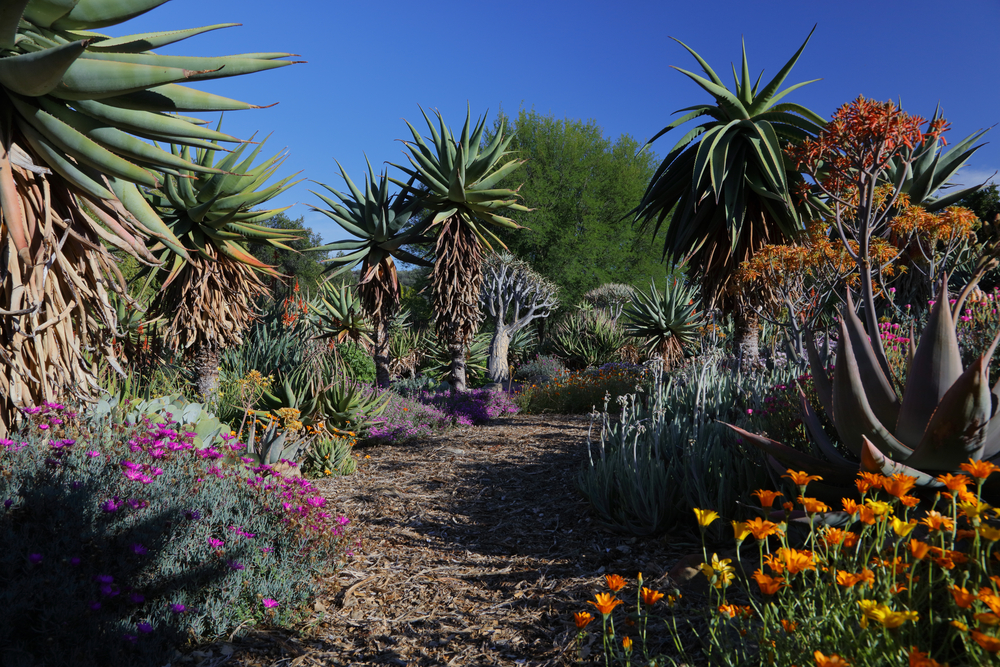A year or so ago, I took a field trip to Ojai and visited a strange and unique garden.
That would be the Taft Gardens and Nature Preserve, located off the 150: a scenic drive that connects Ojai to the 101.
Way off, in fact: After entering through a pair of crumbling gate pillars, you cross a couple of creeks, pass many large rambling private residences, and up a winding, isolated drive come at last to the Visitor’s Center.
A day and time must be reserved in advance, and in spite of its relative isolation, I feared the place might be overrun with people.
Instead, for my hour-and-a-half visit I had the entire 15 acres to myself: the South African Garden, the Australian Garden, the Aloe Garden, the Agave Cactus Garden, the Lily Grove Lawn, the Zen Garden, and the Eco Garden Pavilion.
The Taft was founded by businessman John Taft, who in 1981 bought 265 acres in the Topa Topa Mountains. He saw the purchase as a kind of experiment. His hope was to begin to see the land and the world with new and different eyes.
After the 1985 Wheeler Fire all but denuded the area of vegetation, he traveled to South Africa, returning with quantities of seed, and having enlisted the aid of landscape architect and South African plant expert Lawrence Nicklin.
He then coaxed the world-renowned horticulturalist Jo O’Connell to relocate to Ojai in order to help establish the Australian Garden. (While you’re in the area, stop by Australian Native Plants, the nearby nursery that O’Connell still runs).
The Taft evokes a sense of quintessential Ojai: part hippy-dippy back-to-the-land, part shrewd real estate investment, all overlain by obsession, fierce independence, love for beauty, creative genius, the capacity to collaborate, and insanely hard work sustained over a period of many decades.
In fact, part of the reason you may never have heard of the Taft is that the foundation has intentionally kept a low profile, desiring to keep traffic and noise low out of deference to its neighbors.
There are picnic benches near the Visitor’s Center and benches and shady nooks throughout, as well as restrooms and water.
Hand-painted botanical tiles, sculptures, and curated art dot the grounds, all blending naturally and unobtrusively into the stunningly lush landscape. Beautifully maintained dirt paths are laid out in such a way that around every corner is a surprise.
Beyond the cultivated garden area lies almost 200 acres of California Open Space protected by a Conservation Easement with the Wildlife Land Trust.
CEF’S current President/CEO, Taft’s granddaughter Jaide Whitman, observes: “We are not a traditional botanical garden. I call it a sanctuary with limited access to preserve the property as a unique experience.”
While preserving the tranquillity and space that make the Taft unique, the foundation is now shifting to a new phase by making the public both more aware of this hidden gem and more aware of its responsibilities to the land and the environment.
To that end, the Taft now offers an “Art in Nature” program and an eight-month “Art in Nature Residency,” the goal of both being to provide the opportunity to develop and explore the relationship of humans to their environment.
Clearly Taft is above all an artist himself, and the garden has been his lifelong canvas. To visit is to enter an alternate world of fantastically baroque flowering agaves, proteas in vivid shades of scarlet and gold, grevilleas with intricately curlicued blooms, banksias, eucalyptus, palms, extravagant stands of aloe and barrel cacti.
I felt as if I were a guest at some exotic villa where the owner had discreetly left me to explore and marvel on my own. If I’d had any idea of the range and distinction of this one-of-a-kind horticultural haven, I would have scheduled my day so as to spend way longer.
Operating under the auspices of The Conservation Endowment Fund (CEF), a nonprofit, the Taft’s mission is to preserve, explore, and educate the public about the land and wildlife of the Santa Ana Canyon.
A related enterprise is the Environmental Education Center in Lakeview, Montana’s Centennial Valley. After buying and renovating the property, the CEF donated it to the University of Utah, in the process establishing the Taft-Nicholson Center for Environmental Humanities Education.
Under development at the Taft are a Native Plant Garden, a self-guided Meditation Walk, and a program providing for the possibility of honoring a loved one through dedicating a plant, tree, or rock and/or exhibiting an honorary work of art.
Natural History Walks, Natural Immersion Walks, Solstice Celebrations, and other events are offered throughout the year.
The website extends this open invitation: “If you would like to use our space as a venue, for a respite, retreat, ceremony, or creative project, please contact us at [email protected]!”
How generous, how slightly off-kilter, how gloriously Ojai is that?

